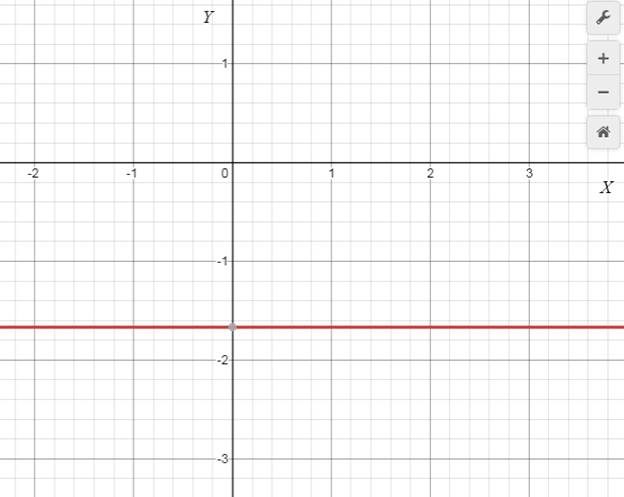
Concept explainers
a.
Calculate the slope and y − intercept (if possible) for the linear equation.
a.
Answer to Problem 47E
The slope of the equation is zero and the y− intercept is
Explanation of Solution
Given:
It is given in the question that the equation is
Concept Used:
In this we have to keep some concept in mind:
(i) The graph of
(ii)Slope interceptform :
(iii)
(a)If
(b)If
(c)If
(d)If m is undefined, the line is vertical.
Calculation: The given equation is,
Since there is no x − value in this equation .
Here we see that , the slope is zero and the y − intercept is
Conclusion:
The slope is zero and the y− intercept is
b.
Sketch the line by hand and by using the graphing utility.
b.
Explanation of Solution
Given:
It is given in the question that the equation is
Graph:

Interpretation:
The equation
So to draw this, pick a few y − values like
Chapter 1 Solutions
Precalculus with Limits: A Graphing Approach
 Calculus: Early TranscendentalsCalculusISBN:9781285741550Author:James StewartPublisher:Cengage Learning
Calculus: Early TranscendentalsCalculusISBN:9781285741550Author:James StewartPublisher:Cengage Learning Thomas' Calculus (14th Edition)CalculusISBN:9780134438986Author:Joel R. Hass, Christopher E. Heil, Maurice D. WeirPublisher:PEARSON
Thomas' Calculus (14th Edition)CalculusISBN:9780134438986Author:Joel R. Hass, Christopher E. Heil, Maurice D. WeirPublisher:PEARSON Calculus: Early Transcendentals (3rd Edition)CalculusISBN:9780134763644Author:William L. Briggs, Lyle Cochran, Bernard Gillett, Eric SchulzPublisher:PEARSON
Calculus: Early Transcendentals (3rd Edition)CalculusISBN:9780134763644Author:William L. Briggs, Lyle Cochran, Bernard Gillett, Eric SchulzPublisher:PEARSON Calculus: Early TranscendentalsCalculusISBN:9781319050740Author:Jon Rogawski, Colin Adams, Robert FranzosaPublisher:W. H. Freeman
Calculus: Early TranscendentalsCalculusISBN:9781319050740Author:Jon Rogawski, Colin Adams, Robert FranzosaPublisher:W. H. Freeman
 Calculus: Early Transcendental FunctionsCalculusISBN:9781337552516Author:Ron Larson, Bruce H. EdwardsPublisher:Cengage Learning
Calculus: Early Transcendental FunctionsCalculusISBN:9781337552516Author:Ron Larson, Bruce H. EdwardsPublisher:Cengage Learning





